Trouble-Love Darkness is a series I was recently reminded of as I finally bought the Venus artbook. To-Love Ru holds a special place in my heart as the first manga I actually read from start to finish. I’m also a slight fraud because I genuinely did not watch or read To-Love Ru Darkness, but from the few chapters I took a look at, it felt like an essay compared to the comedy-ecchi relief that was in the original. Additionally, the shift from Lala as the main character to Momo didn’t feel as good. Momo was initially a side character as she was one of Lala’s younger sisters. Having her transition into the main heroine felt rather weird given her development in the original was minimal. And the whole subplot with the harem plan was just awkward. Given the first story’s light plot on the hilarious daily and often perverted love troubles of Rito, the dive into a sudden harem-centric idea needlessly complicated the general light comedy relief.
To-Love Ru is a very weird series to discuss in the context of the game. The title of this series review is genuinely misleading because the series isn’t about To-Love Ru but rather it’s sequel as I’ve stated in the intro paragraph. Nevertheless, To-Love Ru Darkness (the focused series in Weiss Schwarz) came out in 2010 following the ending of its predecessor, the more famous To-Love Ru. To-Love Ru was already an oddball series which was infamous for its highly perverse scenes and antics. It was also published in Shounen Jump, a magazine that published shounen manga, series focused on writing for young and adolescent boys which usually heavily involved fighting characters and martial arts.
The series is infamous enough to be mentioned or referred to multiple times in another famous anime/manga series, Gintama, as a recurring meme. According to the wiki page, the writer and illustrator stated, “[To-Love Ru] tested the boundaries of what would be allowed in a shōnen manga.” Darkness picked up where To-Love Ru had ended with the plot diverging to focus on one of the younger sisters of Lala, one of the original love interests of the male protagonist, Rito Yuuki. Momo Belia Deviluke decided to carry out her harem plan to try to get Rito to romantically attract and accept all the prior female interests (including her, her other sister, and Lala) instead of letting any single female interest monopolize him.
In terms of Weiss Schwarz, To-Love Ru Darkness 2nd (yes, to make matters more complicated, the series opened in Weiss Schwarz on the second season of the sequel series), came out with a trial deck in early summer of 2015. Following its trial deck release, later that same year in the fall, To-Love Ru received its first booster release with a sequel coming out early in spring the next year.
As a Weiss series, To-Love Ru came out at a very interesting time. You can read more about this here. Weiss Schwarz, as a game, was becoming more standardized at this time. If anything, To-Love Ru was a poster child for the standard skeleton structure which would be defined as modern Weiss Schwarz. The series itself had one of the earliest hand generation combos in the early game followed by a relatively powerful finisher during its prime. To-Love Ru was balanced by traits, which, at the time, heavily organized and limited the structure and cards that you could use.
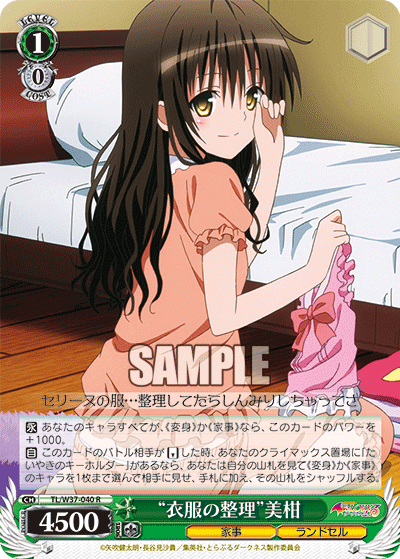
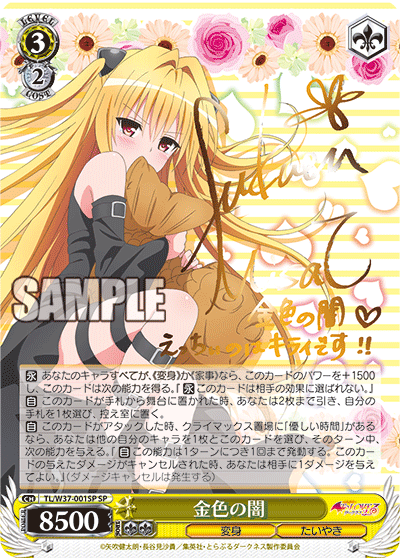
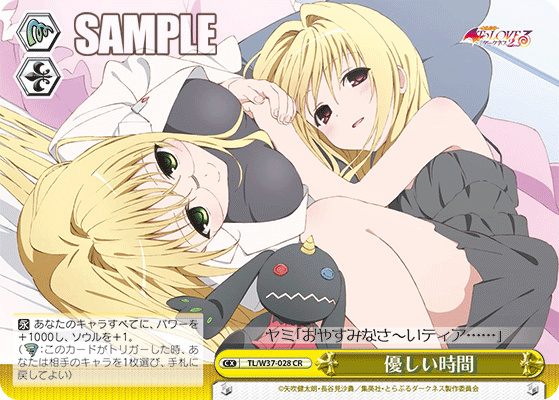
TL/W37-001SP-SP 金色の闇 (center)
TL/W37-028CR 優しい時間 (right)
金色の闇! If you say this name at a local shop full of oldies like me, you’ll be likely to stir up some memories. The most infamous deck profile during To-Love Ru’s prime was that of the Household (家事) /Transformation (変身) deck. It featured all that you could want in any modern deck of that time with plussing combos, plussing brainstorms, and powerful backups to maintain board (with a money counter too). The deck focused around three characters, Mikan, Yami, and Mea, who would unite together to dominate the format at the time.
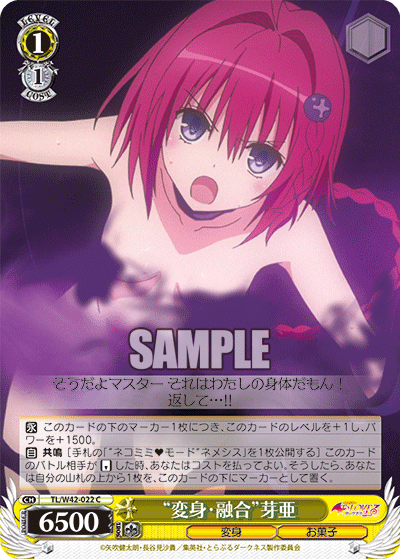
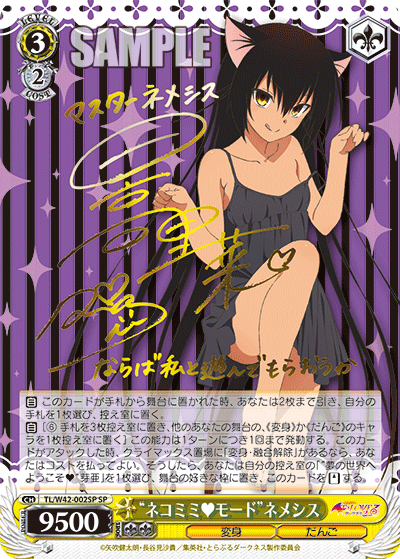
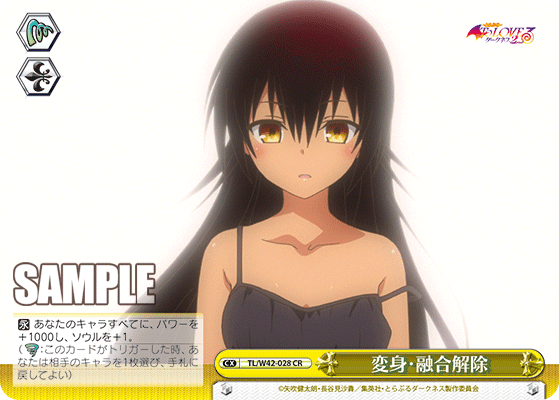
TL/W42-002SP-SP “ネコミミ▽モード”ネメシス (center)
TL/W42-028CR 変身・融合解除 (right)
Following the second booster release, a new specialized deck came in the form of Nemesis. Nemesis would unite with her secret spy, Mea, and build towards a spicy spawner combo with Nemesis herself. The deck utilized RESONATE mechanics which were quite groundbreaking at the time. Many of the cards in the deck would RESONATE with the level three Nemesis, providing a bunch of nice power and utility effects to support your plays.
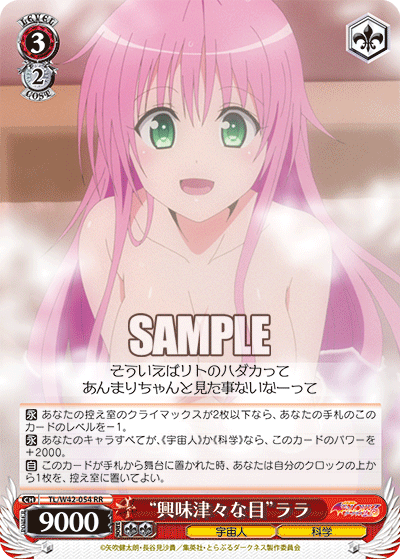
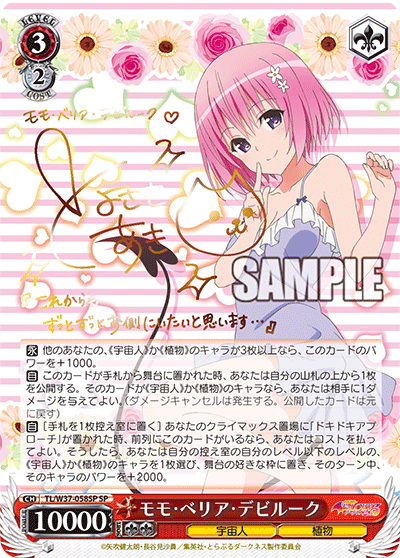
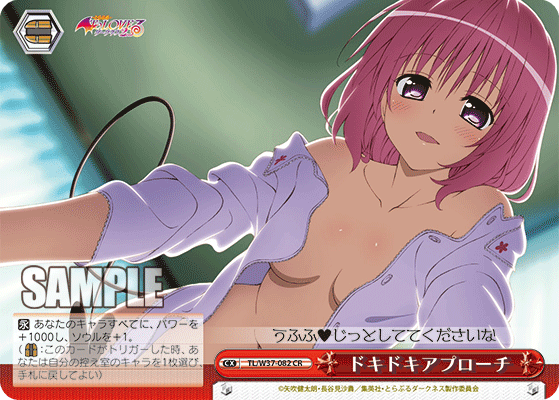
TL/W37-058SP-SP モモ・ベリア・デビルーク (center)
TL/W37-082CR ドキドキアプローチ (right)
Move over, the three troublesome meddling Deviluke sisters have arrived! Momo, Nana, and Lala, form the backbone of the Aliens (宇宙人) deck. Using their combined strengths, you would punish your opponents with Momo’s devilish pranks, Nana’s reserved cuteness, and Lala’s bold approaches.



TL/W42-079R-RRR “ハーレムの誘い”春菜 (center)
TL/W42-050CR 気になるあの人 (right)
Lastly, the powerful green, blue, and red combination brought together the Animal (怪物) gang. The deck was mainly full of Yui and Haruna, but you could splash in Nana as an option as well due to her being part Animal trait. Overpower your opponent and then close out the game with Yui’s clock kick combo, Haruna’s spawner combo, or even Nana’s generic on-reverse costed ping one. And to add insult to injury, pressure your opponent by making them guess if you have the infamous paw-print event in hand or not.
To-Love Ru genuinely sparks some warm memories of my high school days. Looking back on it, it probably wasn’t any literature that I would define as a literary masterpiece, but for what it was worth, it was entertaining for my youthful eyes (maybe even now). Compared to the sets nowadays, it may not be as explosive or powerful, but it does bring home its own merits and feelings of nostalgia. If you’re looking for a bit (or a lot) of lewdness, some lighthearted comedy, and maybe a reflection of your mid to late teens, To-Love Ru may be the right series for you.






